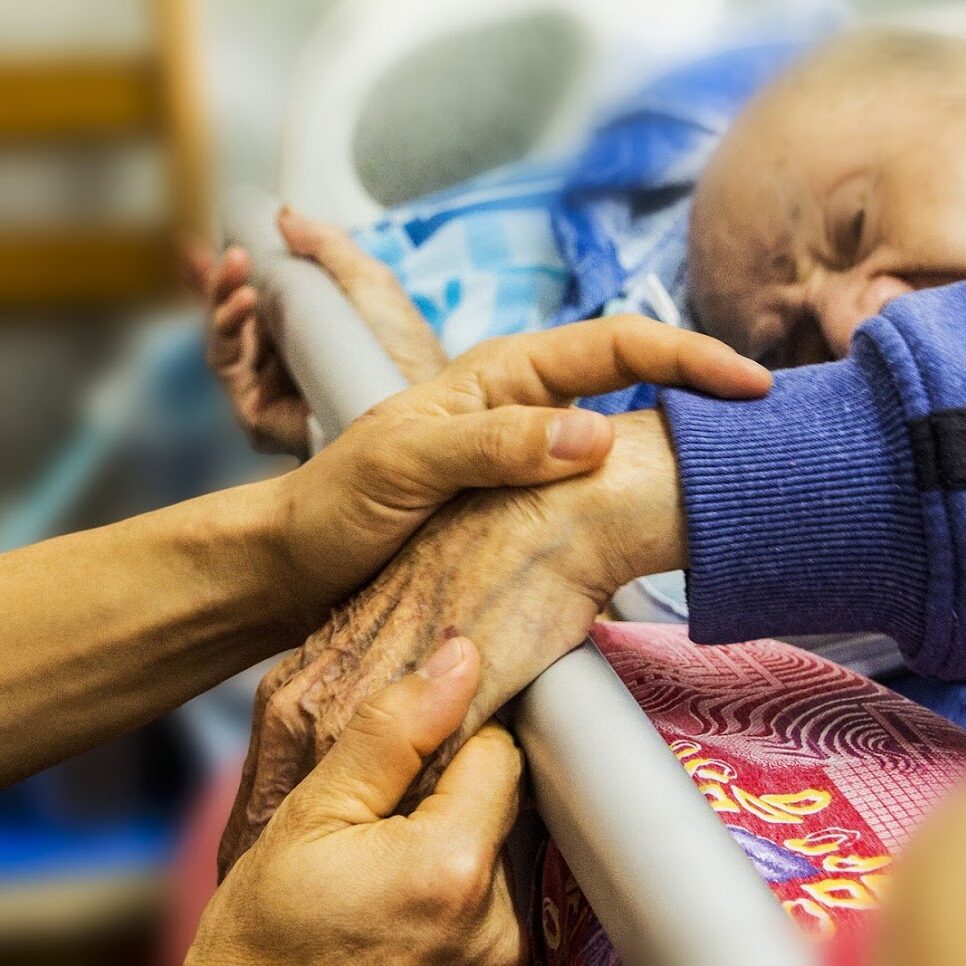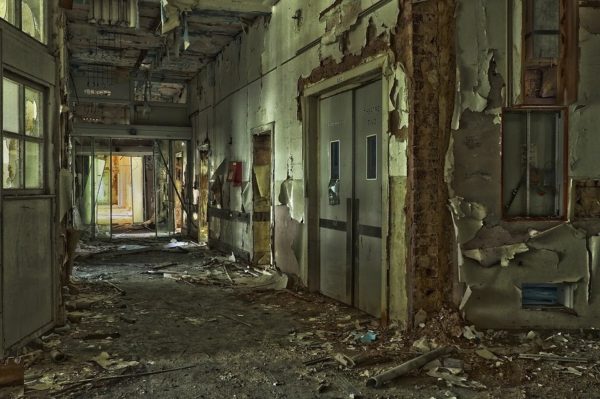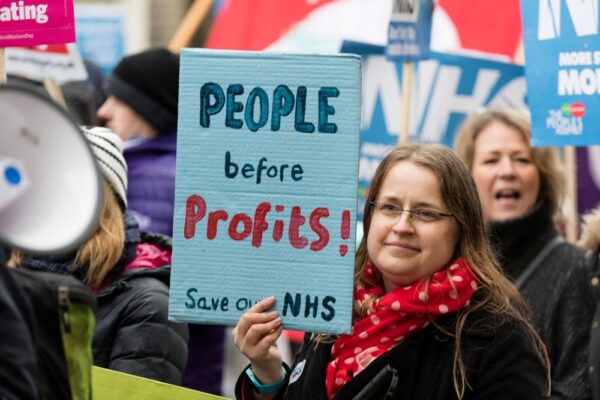
Long-term care and intermediate care includes services provided by residential nursing/care homes and care provided within your own home. This is a complicated area where care provided free by the NHS meets means-tested care provided by social services. After 40 or so years of a policy of privatisation in this sector, service provision is almost exclusively by the private sector, with only a small amount provided by local authorities and the not-for-profit sector. The competitive, for-profit model means investor returns have become more important than quality care and worker pay.
Funding for this sector has been a major target of austerity policies and as a result providers are facing financial melt-down and a workforce crisis. The level of privatisation in this sector means that local authorities and NHS organisations have very little control over service provision and if companies go bankrupt or decide to leave the market, all they can do is pick up the pieces. The largest private companies in this sector are owned by hedge funds and overseas investors, with profits going to tax havens.
Privatisation
Private sector involvement in the long-term care market began in the 1980s; it was one of the first targets for outsourcing of public services to the private sector.
In 1990 the National Health Service and Community Care Act restructured councils as 'enabling authorities' as opposed to care providers. Councils were required to spend 85% of their funding on purchasing care services from the private sector.
Data from the Public Sector Network in 2025 showed that 93.6% (9,235 homes) of care homes are owned by private entities and just 592 by councils and 41 by NHS trusts.
Residential care
Since the 1980s there has been a trend away from the small companies in the care home sector to larger chains and larger homes.
Chain operators have dominated the market for building large residential and nursing homes with 60 or more en-suite bedrooms. In London, big chain companies already provide the majority of the available beds.
The Centre for Research on Socio-Cultural Change (CRESC) describe this change in the market as a 'Travelodge model'. The homes are built with the purpose of minimising staff needed and maximising profit, as opposed to focusing on the needs of the residents.
The largest companies in 2025 all with over 100 care homes are as follows: HC-One (279 care homes); Barchester Healthcare (270 care homes); Care UK (178 care homes); Anchor (121 care homes); Bupa (113 care homes); and Avery Healthcare (104 care homes).
Home care
There are approximately 13,000 different regulated providers for home (domiciliary) care services, some operate across the UK but many operate in a single geographical area. The companies operate under contracts with local councils and NHS organisations.
Issues
The long-term care sector is an example of what happens when government loses control of the providers of a service. Almost the entire social care sector, residential and home care, is privatised; these companies have to make a profit from service users or face bankruptcy. The privatisation of social care was supposed to lead to better care and more choice for people; what it has led to is a system of declining care standards, widespread financial instability, poorly paid staff, and money siphoned off to tax havens.
There are six major issues for this sector, according to the King's Fund:
- Access: means testing, unmet need and selling homes to pay for care
- Quality of care: 15-minute care visits and neglect
- Workforce pay and conditions: underpaid, overworked staff
- Market fragility: care providers struggling to stay in business
- Disjointed care: delayed transfers of care and lack of integration with health
- The postcode lottery: unwarranted variation in access and performance
The government has established a commission, led by Baroness Louise Casey, to set out recommendations for a ‘fair and affordable’ social care system. The commission began its investigations in May 2025.
Whatever the outcome of the commission, it is difficult to reconcile an industry whose leading companies are paying directors millions, and making large profits for hedge funds and private investors, often based overseas, with one that is justified in receiving more money from taxpayers.
In an article for the Guardian in August 2021, Christine Corlet Walker of the Centre for the Understanding of Sustainable Prosperity at the University of Surrey notes:
"the financial structure of many of these companies means that the crisis in social care in the UK does not have just one cause, nor one simple solution. Chronic underfunding, an ageing population, the Brexit-induced labour shortage and the devastation wreaked by Covid-19 have all played a part. But the problems forcing the care system to the brink of collapse don’t just come from a series of exogenous shocks – they are internal too. The very structure of the sector is unstable."
In the paper Careless finance: Operational and economic fragility in adult social care authored by Christine Corlet Walker, Angela Druckman and Tim Jackson, at the University of Surrey, the authors conclude that:
"adult social care is ill-suited to being operated as a market, for four specific reasons. First, it has limited scope for labour productivity growth. Second, local authorities have the power to set prices unsustainably low. Third, there is an inherent lack of consumer access to information about price. Fourth, consumers have scant ability to express preference and exercise choice about providers. These factors place social care in acute danger of predatory financial practices."
Profiteering
The vast majority of care homes are now owned by private companies. In a Panorama programme in December 2021, Jeremy Hunt, former health secretary, said that finances of some of the UK's biggest care providers should be investigated by the competition watchdog. Three of the UK's biggest care home groups are owned by private equity companies and are saddled with significant amounts of debt. The Panorama programme focused on HC-One. The programme reported that HC-One has a web of more than 80 companies in its structure. Some of them own the physical care home properties, others run the care parts of the business. But there are many more companies with less obvious functions. Several of those at the top of the structure are based overseas in the tax haven the Cayman Islands.
HC-One is now majority-owned by Safanad, a US and Dubai-based company run by Kamal Bahamdan, a wealthy Saudi and Olympic bronze-medal-winning equestrian. There are also other smaller investors, which include US private equity firm Formation Capital and UK-based Court Cavendish. The programme reported that in accounts filed by one of HC-One's companies (FC Skyfall Holdco 3), it can be seen that it paid out £4.8m in dividends in May 2020, but just a few days later, as the Covid-19 pandemic took hold, HC-One wrote to every council it works with, asking for additional support to cope with the impact of the disease. The company received £18.9m from a Covid support fund, according to a report in the FT.
In December 2021, iNews reported on the pay discrepancy between staff and directors for the four largest for-profit care home providers, by number of beds, which are owned either by private equity companies, hedge funds or offshore investment firms. The analysis of their accounts show large gaps between executive and employee pay, even among those businesses that cut executive pay during the pandemic. For example, Barchester, owned by Jersey-based investment firm Grove Ltd, pays its care staff between £9 and £10 per hour, with a carer working 36 hours per week on £18,820 per year while Barchester Healthcare’s 2020 accounts show its highest paid director earned 120 times more at £2.27m.
Care UK while owned by private equity firm Bridgepoint Capital, increased overall director remuneration from £2m to £3m in 2020, its accounts show. Its highest paid director for the period received £900,000, which was the same level as in 2019, but one of its care workers earned £18,720 per year on a 36-hour week. This suggests its highest paid director earned 48 times more last year, according to Care UK’s accounts.
In February 2022 The Times reported that Caretech Holdings, the UK’s largest private provider of children’s care homes, sent more than £2 million to its founders’ offshore company in the Caribbean while accepting huge sums in government Covid support. The company had posted soaring profits in the past two years despite having care homes that are among the worst-rated in the country. The company, whose income is largely taxpayer-funded through local authority payments, recorded an operating profit of £79.5 million in its last accounts, up 49% year-on-year.
Historical Financial Instability
Since 2010, government reductions in local government funding has been a primary austerity measure. All local authorities have sought to cope with the resulting funding crisis by reducing the fees paid to care providers in both the residential and the home care sector.
In the residential sector, the private companies have tried to claw back profits in several ways, including charging much higher fees to users who pay privately and reducing the number of staff, sick pay, break times and training. Self-funding residents are paying on average 43% more than state-funded patients for the same care. This disparity in payment means that a two tier system is operating, with residential care homes reluctant to take too many state-funded patients.
Many companies in the residential care sector, in an effort to increase their profits, have resorted to complicated business models backed by private equity and are now reliant on risky financial structures. This leaves them exposed to collapse, with damaging consequences for care home residents. One example of this is the 2011 collapse of Southern Cross, a large national care home provider which had 9% of the market nationally, although within the northeast, Southern Cross accounted for around 30% of all care home places. The company's collapse risked the care of 37,000 people.
The reasons for the Southern Cross failure were many, but all related to the fact that as a private company it needed to make a profit. The company's finances involved a complex mix of creditors, property investors, bondholders, banks, shareholders and landlords and the think-tank CHPI notes that as the company struggled with debt and a reduction in income there was "a reduction in property maintenance, which in turn led to lower occupancy; loans attracting higher interest rates because the company no longer had properties against which to secure loans; a fall in market confidence and the share price; and poor management and quality of care, which led to adverse inspection reports and further decreases in occupancy levels." As it was a private company, the local authorities had no control over the situation, all they could do was try and pick up the pieces after its final collapse.
In the end other private companies took over the contracts, however the main company that picked up the contracts, Four Seasons, was also on the brink of financial downfall by the end of 2017. The uncertainty around the company was only relieved when it struck a deal with US private equity investors and deferred debt payment. Financial stability didn't last long as in March 2019 Four Seasons went into administration. It was reported that this move will not affect the residents lives or the staff as there are no plans to close its 322 care homes.
The instability of the social care market continues. A survey of nearly half of the local authorities in England who commission social care found that 77% experienced provider failure in 2015/16 and 74% believed another failure was going to be likely in the following year.
In November 2016, a report by OPUS found more than one in four care homes across the UK will be facing a financial crisis over the next three years; this means that more than 6,000 care homes could close if they are not rescued by a new owner. The study looked at 6,178 operators that run 96% of the UK’s care homes, looking after 300,000 elderly and vulnerable residents. The report also noted that 751 operators (12%) are ‘zombie’ companies with higher liabilities than the value of their assets. Between them they have a negative equity of £167 million; this figure has risen by 53% since March 2014. The OPUS survey did not cover 750 care homes owned by three private equity companies, including those run by Four Seasons, HC-one and Barchester. These companies are owned by offshore companies and comprehensive financial data was not available. If these companies have been included the sector's financial health would have looked even worse.
The financial stability of the care home companies show no signs of improving. Private equity firms view social care as a lucrative market and have amassed huge amounts of debt buying up care homes. This could easily trigger a financial crisis that would leave local authorities to pick up the pieces, as with Southern Cross in 2011.
In March 2019, accountancy firm BDO reported that more than 100 care home operators collapsed in 2018, taking the total over five years to more than 400. Its report warned that as homes closed many patients would have nowhere else to go but hospitals.
In October 2019. the Guardian reported on documents leaked from the CQC on the financial state of Advinia, a company that had grown to 10th in the English care home market via the acquisition of 22 BUPA homes in April 2018. The CQC is concerned about the company's cash flow and ability to pay its debts. In late August 2019, the CQC warned over 150 local authorities in England and Scotland that Advinia was not cooperating in a financial investigation and the CQC could not give the company a clean bill of financial health. The local authorities now have to decide whether to use the company as a provider or not. According to the leaded documents, Advinia is not cooperating with the CQC and there are also concerns about the “competency and capabilities” of Advinia’s finance department as the company has had four finance directors over five months.
With the sector facing financial problems, the quality of the care that they provide to residents has been found to diminish – the facilities deteriorate, staffing levels are reduced and additional ‘services’ for residents, such as outings and entertainment, are cut back.
Research by Which (click here for Infogram) showed that the care homes owned and ran by private equity firms were among the worst in terms of CQC ratings of inadequate or requiring improvement.
Financial instability is also a major problem in the home care market. In 2017, a report produced by the Local Government Unit think-tank and Mears, one of the leading home care providers, concluded that the home care business was on the brink of collapse; companies were either going bankrupt or pulling out of contracts. Mears reported that it is losing £3 million per year on its home care business and is now pulling out of some local authority contracts and being very wary about bidding for new ones.
In March 2017, an investigation by OPUS, Company Watch and BBC Panorama found that care firms have cancelled contracts with 95 councils, saying they cannot deliver services for the amount they are being paid. The research also found that 69 home care companies had closed in the preceding three months and one in four of the UK's 2,500 home care companies is at risk of insolvency. In March 2017, Mitie sold its home care division to specialist healthcare investor Apposite Capital for just £2; Mitie bought the division for £111 million in 2012. Mitie blamed cuts to payments by local authorities and the increase in minimum wage.
In October 2018, the CQC took the unprecedented step of writing to 84 local authorities with concerns for the financial stability of Allied Healthcare and its ability to continue to provide home care services past 30 November 2018. The CQC warned that as many as 9,300 elderly and vulnerable people are at risk of losing their home care services. The CQC was concerned that Allied Healthcare would not be able to make a loan payment due at the end of November. The company was saved from going into administration by its sales to Health Care Resourcing Group for an undisclosed sum in December 2018.
Home care companies had sought to maintain profitability by the adoption of the flawed ‘task and time’ model with units of as little as fifteen minutes care per client imposed in order to reduce costs. This approach received considerable criticism, however, and statutory guidance introduced in 2015 stated that this short time was not appropriate. Despite this guidance, in February 2018, a report by the disability charity Leonard Cheshire found that around 20,000 people still received visits of 15 minutes or less.
A workforce crisis
The long-term care market has a workforce crisis, with major and growing problems in recruitment and retention. The biggest cost of providing personal care is paying for the frontline staff that deliver the care, so this area has been targeted for cost restraints in order to retain profit margins in private companies.
Brexit and changes to immigration and visa rules have exacerbated the workforce crisis that was already brewing due to poor pay and conditions. In 2025 there were around 111,000 vacancies at any one time, according to the 2025 State of the Adult Social Care Sector and Workforce report by Skills for Care.
Most observers believe that better pay and conditions are critical factors in recruiting more staff. Although pay has risen as a result of the National Living Wage, care workers are still paid, on average, less than shop assistants and health care assistants in the NHS. The fact that more than half of home care workers employed on zero-hours contracts and most are not members of trade unions is also a major factor. Other factors are the lack of training and support the staff need to carry out complex, difficult tasks for vulnerable adults, and the lack of a career structure. Care workers with five or more years’ experience are now paid, on average, only 4p an hour more than new entrants.
What this means at the grass-roots level is that vulnerable patients are going without the care they need to live at home, basic help with getting up, dressed and fed, families are waiting months for care packages to be put in place, and patients that no longer need hospital care can not leave but are stuck taking up bed space that could be used by one of the millions on the waiting list for surgery.
What this means for the staff still working is that many are having to regularly work 60 hours a week, or more if they are required to be on-call. Such long hours are not sustainable, but as the shortage of care workers increases, they are going to become more and more widespread, with the resulting increased loss of staff.
Pay has been an issue in the care sector for many years, now as vacancies rise in other sectors, why would you stay in the care sector when in many cases workers are being paid below the Real Living Wage (RLW). In July 2021 an investigation by ITV, the Bureau of Investigative Journalism (TBIJ) and the Mirror found that many home care workers are still paid below the RLW, even though dozens of councils have pledged to pay at least that rate.
The investigation found 60% of all home care jobs advertised in the previous six months offered a wage which would not be enough to live on. This was more than 7,000 advertised jobs offering less than the RLW of £9.50 an hour in the UK and £10.85 in London. In Wales, the investigation found 75% of care work ads offering below the RLW.
The Skills for Care report shows that Brexit and new immigration rules have compounded the workforce shortage with a fall in foreign staff coming to fill vacancies.
A series of changes to immigration rules beginning in January 2021, with the most recent in July 2025, has meant a rapid drop in the number of international recruits to social care, according to data from Skills for Care.
Changes in March/April 2024, led to a drop in the number of people starting direct care providing roles in the independent sector, after having arrived in the UK, down from 105,000 in 2023/24 to 50,000 in 2024/25.
In July 2025, changes to immigration rules meant care workers and senior care workers were
removed from the Health and Care Worker visa route for new overseas recruits. These changes to immigration policy have caused large changes in the number of people recruited internationally over the period which has also impacted the vacancy rate. From April to September 2025, just 15,500 people were recruited internationally.
Companies
Four Seasons
Four Seasons was once the second largest provider of care homes in the country. The company had severe financial difficulties and is no longer an operating company.
In 2021, Active Care Group acquired the Huntercombe Group, the mental health care business of Four Seasons, from the administrators of Four Seasons.
In 2023 Four Seasons began the sale of its freehold care homes, the sale of 57 freehold care homes was completed in 2024 and in February 2025, entered into an agreement to sell the business and assets of all its remaining 46 freehold care homes across England, Scotland and Jersey for £241m. Gold Care acquired two homes and Omega acquired the remaining 45 care homes which will be leased to six operating partners. The operators include Gold Care, Harbour Healthcare, Springcare, Belmont Healthcare, and Jersey-based LV Group.
The Four Seasons Group was owned by Guy Hands' Guernsey based private equity company, Terra Firma and at the end of 2017, the company had £525 million worth of debt mainly owned by H/2. There were major concerns for the future of Four Seasons as it admitted it could not afford the debt repayments it had due. However, in 2018 the company came to a deal with its creditors. Financial stability did not last long and in April 2019 the company was put into administration.
HC-One
HC-One came to prominence following the collapse of Southern Cross in 2011 and being bought by finance firms Court Cavendish, Formation Capital and Safanad in 2014.
Since 2014, the company acquired the care providers Meridian and McArdle Care. In 2017, the company bought 122 care homes from Bupa taking its total number of care homes up to 350.
In 2025 Companies House lists a series of holding companies between HC-One and HC-One Finco Ltd (previously known as FC Skyfall (UK) Financeco Ltd.)
A December 2021 Panorama programme focused on HC-One and reported that HC-One has a web of more than 80 companies in its structure. Some of them own the physical care home properties, others run the care parts of the business. The report noted that HC-One was majority-owned by Safanad, a US and Dubai-based company run by Kamal Bahamdan, a wealthy Saudi and Olympic bronze-medal-winning equestrian. There are also other smaller investors, which include US private equity firm Formation Capital and UK-based Court Cavendish. The programme reported that in accounts filed by one of HC-One's companies (FC Skyfall Holdco 3), it can be seen that it paid out £4.8m in dividends in May 2020, but just a few days later, as the Covid-19 pandemic took hold, HC-One wrote to every council it works with, asking for additional support to cope with the impact of the disease.
Bupa
Between December 2017 and February 2018 Bupa completed the sale of 132 of their UK care homes. Despite this the company remains one of the largest care home providers, with 125 care homes and 6,000 residents. It is also in the process of building four new care homes in England.
Barchester
Barchester, founded in 1992, is one of the biggest independent care providers in the UK, with over 200 care homes and seven registered hospitals across the country.
The organisation employs over 17,000 staff who care for over 11,000 individuals in care homes which offer a range of services from residential and nursing care to dementia care and more. The ultimate parent company is Grove Ltd registered in Jersey, according to documents filed with Companies House.
Mears
Mears UK Ltd, founded in 1988, operates UK-wide in the housing and social care sector. The company has built up a domiciliary care business through the acquisition of companies, most recently in 2015 the domiciliary care division of Care UK. In 2018, the company reports that its care teams deliver approximately 180,000 hours of care and support each week on behalf of 127 local authorities and a number of clinical commissioning groups. The company has over 6,000 care workers that support 30,0000 people.
MC Care
MC Care was created in 2017 by Apposite Capital following the acquisition of MiHomecare and Complete Care from Mitie Group plc. MiHomecare provides domiciliary care services for the elderly and disabled, whilst Complete Care provides nurse-led complex care solutions. Both companies still operate under their pre-acquisition company names.
City & County Healthcare Group
In December 2020, Interserve Group announced the sale of Interserve Healthcare to City & County Healthcare Group (C&C). Interserve Healthcare provided complex and critical community healthcare to patients with a wide range of medical conditions across England, Wales and Scotland. C&C is one of the largest providers of homecare services in the UK. The Group operates from 200 locations in the UK and offers services across all homecare segments.
Health Care Resourcing Group
Originally operating as Allied Healthcare, it is one of the largest providers of domiciliary care in the UK providing around 13,000 people with care across the UK, including Wales and Scotland. Much of this care is under NHS contracts.
Allied Healthcare was owned by German private equity investor Aurelius. In October 2018, the company was reported to be in severe financial difficulties and the Care Quality Commission warned that around 9,300 elderly and vulnerable people could be at risk of losing their care. The CQC wrote to 84 local authorities to warn them of the situation and that there is a “credible risk” that Allied Healthcare may have to stop its services when a loan payment becomes due at the end of the month. In December 2018 the company was saved from bankruptcy by its sale to Health Care Resourcing Group (HCRG) for an undisclosed sum.
Background
What services come under long-term care?
Long-term care, or social care, services provide people with nursing and practical support if needed due to old age, illness, or disability.
The support provided can be at home, within the community or through providing you with a new residence in a care home. Funding for care is complicated as some can be provided free by the NHS, regardless of financial status, via Continuing Healthcare Packages, whilst other care considered to be non-medical is means-tested. Generally, most people have to pay for some of their care and support, but local authorities have a duty to assess everyone's care and support needs.
Who commissions long-term care?
Residential and home care services are commissioned by local authorities and NHS trusts. Some NHS organisations and local authorities have framework agreements listing a large number of providers. Most local authorities buy care piecemeal via an auction system where contractors bid to provide a care package for each elderly or disabled person.
Many NHS trusts have contracts with care homes for what are known as ‘step-down’ beds as a means to improve discharge rates, this is also referred to as intermediate care. The hospital trust discharges patients to a step-down’ bed if they no longer require acute care, but are not well enough to go home.
Who provides long-term care?
The vast majority of residential and home care is provided by private companies with a small number of local government staff, not-for-profit organisations and charities involved.
A 2018 blog post on London School of Economics and Political science website reported the extent of the growth of private sector involvement in social care over the last 30 years. By 2012 the number of residential or nursing home beds provided by local authorities or the NHS was down to 6%, compared to 64% in 1979. The care home sector has around 410,000 residents, spread across 11,000 homes with 5,500 different providers. Even more significantly, home care services have over 11,000 different regulated providers giving help to over 900,000 people. Many home care services are run on the franchise business model, for example Bluebird Care.






